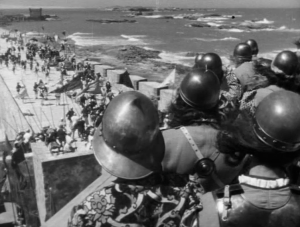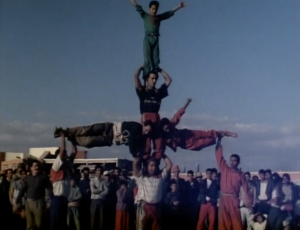Summary:
We are generally accustomed to thinking of the transnational in world cinema as something new or recent, a condition that has emerged due to a number of conjunctural factors such as the increase in coproduction and multistate financial arrangements, the migration and movement of diasporic filmmakers, the mutability of genres across national borders, the appearance of global stars, or the increase in international shooting locations to stand in for other places. Indeed, many of these developments were noted in the call for papers for the conference, which proposes that the last two decades in particular have shown the usefulness or appropriateness of this term for Moroccan cinema. I want to both acknowledge that assessment and also extend our focus back in time, by suggesting that some qualities of the transnational have long been present in Moroccan cinema. I make these claims in three connected terrains: first, I will show that Moroccan cinema has always been transnational, in that it has always been the unstable site of multiple fields of production and distribution. Second, I argue that while non-state and transnational financing arrangements have often constituted an alternative or supplementary mode of production to that funded locally and by the CCM, it should not follow that a wholly Moroccan-funded film is always more “authentic.” Third, in paying attention to the qualities of the transnational in the domain of cinematic language and representation, I argue that cinema offers a critical engagement between Morocco and other parts of the world. I make these three claims with the hope that we might see cinema in Morocco as having the ability to be at once local in its address of the popular, and “worldly” in its participation in what we could name the “transnational,” but which we might more properly call the cinema tout court. Rather than think of the transnational as some kind of new condition, then, I propose that we think of cinema as “always already” worldly and that we instead pay attention to the criticality, shape, and scope of its interventions as a modern form. Moumen Smihi’s body of work over forty years offers a telling way to trace the contours of such a transnationality.
Early Transnationality

From the actualities shot by the Lumière operators to those of the Protectorate years, cinema in Morocco was tied up with the experience of French colonialism from the beginning. Yet other transnational flows began early, too. La rose du souk (Jacques Séverac, 1930) was the first film to star a Moroccan (Leila Atouna) and was shot in Morocco with post-production in Berlin. It was an adventure film in the tradition of Hollywood silent adventures like those starring Douglas Fairbanks—The Mark of Zorro (1929) or The Thief of Baghdad (1924). The studios at Souissi, founded with French capital in the 1940s, aimed to rival Hollywood in North Africa and produced several films in dual-language versions of French and Arabic. Long before Hollywood discovered Ouarzazate, Orson Welles shot Othello (1951) at Essaouira and Kenitra and Hitchcock filmed scenes for The Man who Knew too Much (1956) in Marrakech. And on the level of exhibition, films from Egypt, India, and Hollywood have long dominated Moroccan screens. The question, then, is not when did Moroccan cinema become transnational, because it clearly always has been. Rather, we might better understand how transnationality is deployed, engaged, and critically imagined or pursued.
Transnational and independent production in Morocco
“Un pays qui ne produit pas d’images est menacé de famine.” – Moumen Smihi.
To read Smihi’s essay “Image de soi, pour soi et pour l’autre” (Smihi 2006) is to be reminded not only of the difficulties for any Moroccan filmmaker in getting a film made, but also of the challenges for filmmakers who refuse to compromise on their artistic vision. Like many other filmmakers frustrated with lack of CCM production funds in the early years of the institution, Smihi sought private financing practices. After shooting his first film, Si Moh, pas de chance (1970), in Paris, Smihi returned to Tangier and made El Chergui (1975). Private financing yielded a shoestring budget, with technicians and facilities provided by the CCM and Éclair in Paris. Smihi’s subsequent films also leveraged overseas funds even as he continued to seek local ones (and his recent films have received avances sur recettes from the CCM). But rather than see such transnational production arrangements as a compromise or mark of inauthenticity we should instead read them as a fact built into the nature of film production in Morocco—a fact that filmmakers have constantly struggled with.
Transnational discourses of modernism and the popular:
As I’ve argued elsewhere, the history of Moroccan cinema in the 1960s and 70s reveals an active embrace of ideas and aesthetic forms from elsewhere, not only within particular films like 6 et 12 (Bouanani, Tazi, Rechich) De chair et d’acier/Of Flesh and Steel (Mohamed Afifi, 1959) and Retour en Agadir (Afifi, 1967) but in the film culture and broader artistic and literary scene of the time. (Limbrick, “Vernacular Modernism, Film Culture, and Moroccan Short Film and Documentary”) These films were notable for the way that they conjoined experimentations in documentary representation with an interest in global modernisms. Bouanani, for example, filled the soundtrack of 6 et 12, with bebop jazz and American rock ‘n’ roll even as his other work continued a longstanding documentation and visualization of Moroccan folk traditions. Such an emphasis on the role of the popular is important for the way that it pushes against another characterization of the transnational—as either inauthentically national or too concertedly “art cinema.” The address of the world in Smihi’s films, as in these earlier examples, embraces the local popular and the global. For Smihi, a Tanjawi, Tangier’s very nature is polyglot, multiple, and comprised of diverse cultures, sounds, and cultural discourses, as is evident in El Chergui. This dance of forms inflects Smihi’s representation of Marrakesh, Essaouira, Tangiers, and Fes in Moroccan Chronicles (1999).

Along with its references to Hitchcock, Welles, Virginia Woolf and Shakespeare, the film also mobilizes innumerable local oral and popular traditions, like the story telling of the hakawati or ambulatory storyteller, the gymnasts in the Jmaa el-Fnaa, or the music and song of the film’s Gnawa musicians.
Such engagements between local and global forms of popular culture and art offer us a different purchase on the idea of transnationality by refusing the hierarchy of the authentic vs. the foreign and by affirming the place that Moroccan cinema might take in world cinema.
Reference:
Moumen Smihi, Écrire sur le cinema. Tangier: Slaïki Frères, 2006.